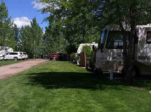Science Smarts: Catch some weed seeds
By PATTY ROOKS on August 27, 2021.
I went on a little hike in the river bottom the other day and by the time I finished my poor dog was covered in all kinds of weed seeds! Oh my, these were not easy to get out either. This made me think that I should take them home and identify what these may be. I know that “Buddy” will not come along again in the near future, so I have come up with an experiment to help me gather a variety of seeds. Let’s get started! Remember to ask an adult before doing this activity. Materials – Pair of good walking shoes – Pair of old wool socks – A place to take a hike – Tweezers – Magnifying glass – Sheet of white paper -Zipper bag – Identification guide for seeds/weeds of southern Alberta Procedure 1. Find a nice place to take a hike. 2. When you are ready, pull the wool socks on over the shoes that you are wearing. 3. Continue on your hike collecting seeds on the socks. 4. When you are finished, sit down, gently remove the socks and place them in a zipper bag. This is important as we do not want to spread these seeds to a new area as they could be “invasive”. 5. When you return home, investigate the seeds at a desk or table inside. 6. With the tweezers, gently pull off all of the seeds that have attached to the socks. 7. Place the seeds on a sheet of white paper and observe them with the magnifying glass. 8. Try to identify the seeds you have collected. Explanation What kinds of seeds can you identify? How did the seeds get there? Seeds really lead a secret life. Without legs, seeds need ingenious ways to get around. Animals and birds spread seeds unknowingly. As you may see, the seeds have small barbs or hooks on them. These hooks attach themselves to animals or anything that comes by them. When they attach to you, they get carried to a new location and left there. They literally hitch a ride to a new location! Seeds can often travel in other ways as well. “Parachuters” such as dandelions, and “winged” seeds, such as those from maple trees, are so light that they are blown easily from place to place. “Shooting” seeds are formed when pods burst open and fire the seeds out. Do not forget to get your applications in for the APAR Initiative STEM and Leadership Cohort for 2021-2022. Praxis only has a few spots left and the deadline is fast approaching for this great opportunity for females in Grades 6-9. Patty Rooks, Senior Scientific Consultant PRAXIS, “Connecting Science To The Community”. Contact Praxis at praxis@praxismh.ca, http://www.praxismh.ca, Tweet or follow us @PraxisMedHat, or friend us on Facebook. Visit us at: #12 826 11 Street S. E., Medicine Hat, Alberta, T1A 1T7 Phone: 403-527-5365, email: praxis@praxismh.ca. 28-27



